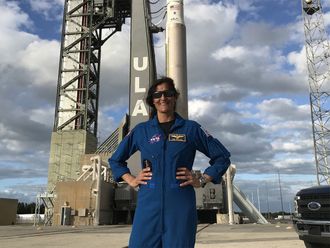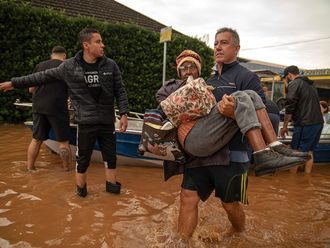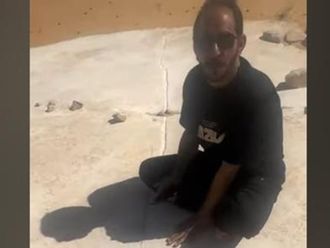
For Bob Schwartz, one of the hardest things about his unnamed illness is sleeping in snatches.
When Schwartz, who battles insomnia, does manage to fall asleep, he wakes up every 90 minutes to urinate copiously. Most nights he sleeps a total of four hours.
Chronic sleep deprivation is only one symptom of a consuming and debilitating constellation of problems that has astonished and baffled nearly 100 doctors around the country with whom Schwartz has consulted since 2016.
Despite his herculean efforts, the 59-year-old retired medical malpractice lawyer turned philanthropist still doesn't have a diagnosis.
In addition to his nocturnal urinary problem, Schwartz suffers from massive shifts of body fluids when he stands up or lies down, very high blood pressure, chronic digestive disorders, severe hormonal imbalances, muscle wasting on his left side and exhaustion.
He has traveled to the Mayo Clinic twice and to the Cleveland Clinic. Last fall, Schwartz, who lives near Detroit, spent a week at the Undiagnosed Diseases Program at the National Institutes of Health. The highly selective 11-year-old effort by the nation's preeminent research hospital is designed to diagnose the most perplexing illnesses.
Yet the former marathon runner remains what one Mayo specialist dubbed him: "a zebra among zebras" - medical slang for an extraordinarily rare case.
NIH doctors have identified an apparent reason for his symptoms - his veins are grossly enlarged and too stretchy - but they don't know why or how to treat it. And they've never seen a similar case.
"We don't have an answer yet," said Donna Novacic, the attending internist at NIH's Clinical Center who coordinated the multidisciplinary team of experts that examined him in Bethesda last year. Schwartz, she noted, "has quite an enduring spirit despite a very complicated problem."
For Schwartz, the singular nature of his case and the lack of a diagnosis have caused moments of existential despair. But he says he has resolved to learn everything he can about the illness that has upended every aspect of his life.
Schwartz said he hopes his story will elicit suggestions that could provide him some relief. Because philanthropic work is the cornerstone of his life, he wants to "help others facing their own battle who can glean something, or reach out to me for advice."
Origin story
Until 2016, Schwartz said, he was "the epitome of health." A vegetarian since high school, he never smoked or drank alcohol. A lifelong and enthusiastic athlete, he ran 10 miles a day and played basketball.
In 2007, Schwartz, then 47, retired from his law practice. With his wife, Robin, a graphic artist, he founded the Here to Help Foundation, of which he is chief executive. The private, nonprofit foundation has awarded small one-time cash grants to more than 7,500 residents of southeast Michigan. Some are newly released prisoners, others are trying to stave off eviction or need money to buy a reliable used car to get to work.
Sometime in 2016, Schwartz said he began feeling tired. During his outdoor runs, his hands and feet felt unusually sensitive to the cold.
"I just thought, 'We'll, I'm getting older,' " Schwartz said.
The urinary problem started in 2017. During the day, no matter how much liquid Schwartz consumed, he produced little urine. "But when I lay down in bed at night," he recalled, the opposite occurred. His nightly urine output totaled about 51 ounces - the equivalent of 11/2 quarts. Urologists could find nothing to explain the phenomenon.
In September 2017, Schwartz landed in Beaumont Hospital, Royal Oak near his home. His blood pressure was sky-high: 180/100, far above his normal 110/65. He had no energy and his extremities, particularly his legs, felt heavy and swollen.
Doctors quickly determined that Schwartz was suffering from hyponatremia, sometimes called water intoxication. The concentration of sodium in his blood was dangerously low, putting him at risk for serious complications, including brain swelling that can lead to coma or death.
Unable to find the cause, doctors transferred Schwartz to the University of Michigan. He spent a week there and doctors were able to control his hyponatremia, which they determined was caused by an unexplained increase in his blood plasma volume. Michigan specialists referred him to the Mayo Clinic. At Mayo, according to an interventional radiologist at Michigan, "his condition continued to amaze and perplex" doctors.
A scan revealed that Schwartz's iliac veins, which feed the inferior vena cava, the body's largest vein that carries deoxygenated blood to the heart, were greatly enlarged, as were his vena cava and his aorta.
But the results of several tests were inherently contradictory. Despite chronic hyponatremia, Schwartz exhibited clear signs of dehydration during the day while upright. But when he lay down at night, fluid gushed back to his kidneys, causing excessive urination.
Mayo experts ruled out several possible diagnoses, including vasculitis, a group of rare diseases caused by blood vessel inflammation.
"They asked me [to] come back in a year to see what had evolved," Schwartz said. When he returned, doctors had nothing new to suggest.
What next?
Schwartz, who is fluent in the language of medicine, spent much of 2018 consulting experts around the country, most via videoconference. He sought out specialists in cardiology, blood vessel diseases and endocrinology, as well as anyone he believed might have a hypothesis about what might be wrong or how to help him.
An interventional radiologist at Michigan referred Schwartz to NIH's Undiagnosed Diseases Program. Schwartz, the radiologist wrote in his referral letter, "has been untiring in seeking an explanation for his illness" and hopes NIH experts could "shed some additional light on what has been a very dark place."
The program, which has seen about 1,200 patients and rejects approximately 80 percent of those who apply, accepted him. "It was a compelling case," Novacic said.
Care offered at NIH and the 11 other sites around the country that constitute the Undiagnosed Diseases Network is free. The effort has several goals: to identify previously undiagnosed disorders, to determine their possible genetic underpinnings and to provide useful advice to suffering patients, even in the absence of a diagnosis.
Since its inception, the network has unearthed a diagnosis in approximately 35 percent of cases and identified 31 new syndromes. Some diagnoses are made through a sophisticated and time-consuming genetic analysis known as DNA sequencing.
"There have been cases that were solved years later," Novacic said. "We may find an answer in the future, even if we don't have it now." Patients are told that their information will be kept in an extensive database and that they will be notified if an answer is found.
In late October 2018, Schwartz and his wife, whom he describes as "a pillar of strength and hope" spent a week at NIH. His team included cardiologists, rheumatologists, vascular specialists, a geneticist and an expert in dysautonomia, a disorder of the autonomic nervous system, which controls breathing and heartbeat.
Schwartz, who called the team "phenomenal," underwent numerous additional tests, including a highly specialized PET scan not available outside the research hospital.
Once again, experts were mystified.
The case that most resembles Schwartz's, Novacic said, is that of a marathon runner with very enlarged veins who suffered from recurrent blood clots. He was seen at NIH several years ago, but so far doesn't have a diagnosis.
In Schwartz's case, the leading hypothesis is that his enlarged and overly stretchy venous system might reflect a subtle problem with the collagen in his connective tissue. It is possible that the collagen, a protein that functions as a sort of scaffolding and holds the body together, is not strong enough to support the walls of his veins. He also shows signs of dysautonomia.
"Years of running might have exacerbated the problem," Novacic said, possibly through the repeated pounding involved. But it is also possible, she noted, that running was in some way protective, delaying the onset of symptoms that might otherwise have materialized earlier. One possibility is that the underlying cause may be genetic.
"Generally when we think of genetic disease, you think of a child born with it," Novacic said. "But there are many situations where you have a predisposition to a certain problem and it doesn't manifest for years."
Novacic said that Schwartz's DNA is being sequenced at Baylor College of Medicine for possible clues. Results are still pending.
To help control daytime swelling, NIH experts recommended that Schwartz wear specialized compression garments.
"Without strong [blood] vessel walls, the only thing you can do is compress from the outside," Novacic said. Unfortunately the team had no advice about ways to curb his nighttime urination.
Novacic said she is acutely aware of the plight of patients like Schwartz who don't receive a diagnosis.
"It is very difficult," she said. "There's a lot of angst and uncertainty."
Schwartz said he derives perverse satisfaction from the knowledge that he has done everything humanly possible to find an answer.
He tries to focus on other things. He exercises every day on a specialized rowing machine to try to maintain some level of fitness. He spends time with close friends familiar with his situation and takes pleasure in his three grown children. Foundation work is a full-time job, providing a strong sense of purpose and serving as a welcome distraction from the physical and emotional ravages of his illness.
Many of the foundation's clients have served time in prison and Schwartz has become friendly with one client who was wrongly incarcerated for decades for a crime he did not commit.
"He knows in a general sense what I've been going through," Schwartz said. The man recently sent him a quote meant to be applicable to both their lives that Schwartz finds particularly resonant.
"Anyone can give up, it's the easiest thing in the world to do. But to hold it together when everyone would understand if you fell apart, that's true strength."












